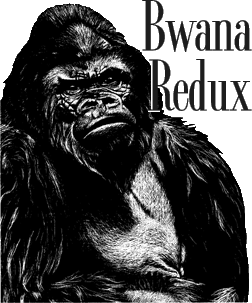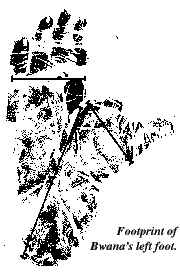

The rare remains of an adult male lowland gorilla, recently dissected at UCSC, will help scientists interpret the fossil bones of ancient humans and primates.
By CORINNA WU
Illustration by Hila Kuepper
A FIRST-TIME VISITOR to the San Francisco Zoo's Gorilla World may not notice anything unusual. It looks peaceful and natural, just a rocky enclosure shaded by a few Monterey cypress trees and dotted with patches of grass. The gorillas quietly ambling about seem oblivious to their human observers. A faint sound of passing cars is the only subtle reminder that Gorilla World is part of a city zoo, and not somewhere in the plains of central Africa.
But to Mary Kerr, one of the gorillas' keepers, one particular spot of flat rock is conspicuously empty. That was the favorite spot of Bwana, the majestic silverback who lived at the zoo for almost 35 years and had a coterie of loyal fans--gorilla and human. Bwana died suddenly in September 1994, not long after zoo veterinarians discovered that his large intestine had ruptured. The veterinarians removed the damaged portion of the intestine, but Bwana never recovered from the surgery. The other gorillas knew he was gone, Kerr says; for days they cried out and vainly looked around for him. Kerr grieved for Bwana along with them.
Yet even after death, Bwana still inspires awe. Over the past six months, he has been giving scientists at UCSC a rare opportunity to learn more about the anatomy of these enigmatic giants. Adrienne Zihlman, a professor of anthropology, has recently completed a painstaking dissection of his body. By studying Bwana's anatomy, she will gain insight into differences between male and female gorillas and how they compare to other apes. Ultimately, she will use her information about apes to build a strategy for looking at early human and ape fossils.
The thought of Bwana in a lab bothers Kerr a bit; she worries that her former charge is being seen as just another specimen. "I just hope they're treating him with respect over there," she says with a sigh.
Kerr needn't worry about respect, says Kim Nichols, an undergraduate anthropology student who is working on the project. Bwana, whose name means "sir" in Swahili, commands respect, even on the dissection table. This is the first opportunity scientists have had in over 40 years to dissect an entire male gorilla. The last was the legendary Bushman from the Lincoln Park Zoo in Chicago. Zihlman has already dissected two female gorillas, as well as many chimpanzees and orangutans. Bwana completes the information Zihlman needs to do a comparative study.
 Even though Zihlman has dissected many apes before, Bwana proved to be quite a
In UCSC's bright and airy physical anthropology labs, gorillas are clearly the
stars of the show. A big inflatable gorilla stands guard in one corner, and
gorilla cards, posters, and stuffed toys decorate the room. Bones sit in neat
rows on a table; some are white and clean, while others still have bits of
blood and hair clinging to them. Nichols dons a pair of latex gloves and picks
one up--a bone obviously fresh from a recent dissection. "This is Bwana's
forearm," she says. She then holds it next to a smaller but similarly shaped
bone from the forearm of a female gorilla. These size differences in the bones
of apes can be used as a yardstick to help sort out whether fossils are from
males and females of one species or from completely different species, Zihlman
says.
Even though Zihlman has dissected many apes before, Bwana proved to be quite a
In UCSC's bright and airy physical anthropology labs, gorillas are clearly the
stars of the show. A big inflatable gorilla stands guard in one corner, and
gorilla cards, posters, and stuffed toys decorate the room. Bones sit in neat
rows on a table; some are white and clean, while others still have bits of
blood and hair clinging to them. Nichols dons a pair of latex gloves and picks
one up--a bone obviously fresh from a recent dissection. "This is Bwana's
forearm," she says. She then holds it next to a smaller but similarly shaped
bone from the forearm of a female gorilla. These size differences in the bones
of apes can be used as a yardstick to help sort out whether fossils are from
males and females of one species or from completely different species, Zihlman
says.
A few steps down the hall from the lab, Nichols swings open the vault-like door of a walk-in freezer where Bwana was kept before dissection. The freezer allowed the researchers the luxury of not needing toxic formaldehyde to preserve the body. "Formaldehyde changes the texture of the muscles and makes it difficult to tell which portions come from where," Nichols says. "I would take the smell of the untreated animal over a treated one any day." Now, metal shelves inside the freezer hold boxes of Ziploc bags containing Bwana's sinewy muscles.
The researchers actually did two different kinds of dissections on Bwana. They dissected one half of his body muscle by muscle, weighing and carefully describing each kind of tissue. They kept the other half in functional segments--groups of body parts that normally move together, like the shoulder and the arm.
challenge. Fortunately, in 1950, a team of gorilla experts wrote a book called The Anatomy of the Gorilla, which Zihlman says has been "extremely helpful" for her dissection of Bwana. The book contains fold-out pen-and-ink drawings and descriptions of the gorilla's muscles, which served as a road map through unfamiliar territory. "His muscles are so huge we could hardly recognize them," Zihlman says. "You think you have three muscles instead of one." The previous work done on gorillas was mostly descriptive; the UCSC project on Bwana is more quantitative. Having a whole gorilla lets the researchers catalog the weights of skin, hair, and muscle as well as the measurements of the bones.
It took several months for Zihlman, Nichols and Robin McFarland, a biology and anthropology teacher at nearby De Anza College, to dissect Bwana's body, working on one segment at a time. Nichols says that some people don't appreciate how hard it is to dissect an animal as large as Bwana. It took her eight hours of careful probing, identifying and cutting just to dissect his foot. "I come out after a day of dissection, and I'm sore all over and a little disoriented," she says. "You have to concentrate because you can't go back and put a muscle back together again after you've taken it off."
As Zihlman analyzes the results of the dissection, she will begin to see the physical differences between male and female gorillas and the range of body sizes within one sex. The physical differences she finds will provide invaluable information about how gorillas get around, as well. "When you're in the forest, all you get is a very general idea of what they're doing," Zihlman says. Weighing the muscles paints a refined picture of a gorilla's locomotor patterns, since the parts of an animal that are used the most are also the heaviest.
Another contentious issue Zihlman's dissection will help anthropologists resolve is that of determing the body weight of fossilized animals. Since it is impossible to put someone who was alive millions of years ago on a scale, the best scientists can do is estimate weight by measuring the ancient bones left behind. Most estimates are based on bone dimensions and body weights of modern humans, but "it's mostly guesswork," Zihlman explains. Chimps and other apes provide more-accurate, present-day comparisons for early humans, she says. Correlating Bwana's limb weights with the dimensions of his bones will provide especially valuable information.
As he did at the San Francisco Zoo, Bwana at UCSC again has a rapt and loyal
audience. "It's amazing how you can generate so much research from one
animal," Nichols says. "I say, 'Bwana, what more can you tell us?' He does
keep coming up with more."
